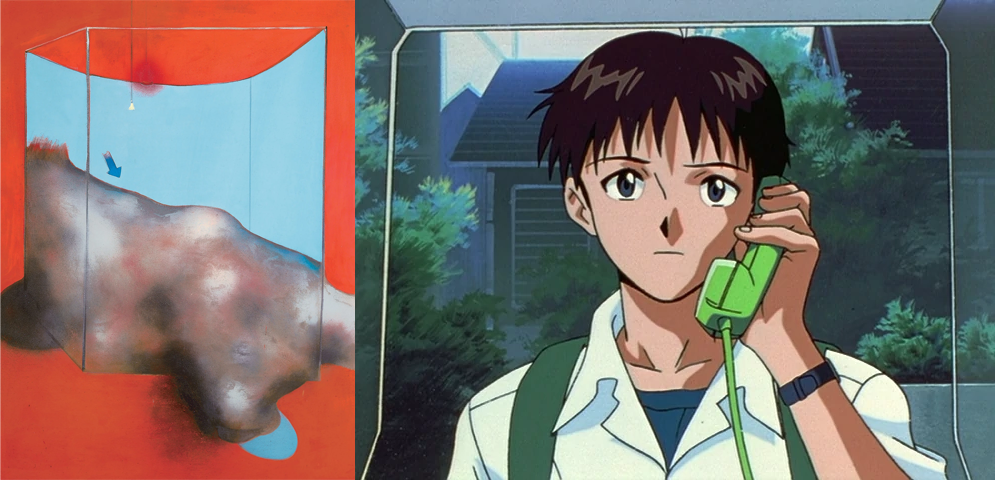
5th of May, 2021

One of the most recognisable aspects of Francis Bacon's compositions is the cage. The subject of the piece (often an ethereal mess of broken butchers meat) was placed in a transparent box indicated only by thin lines running along the edges. In Neon Genesis Evangelion the first shot of the main character, Shinji Ikari, has him framed by the transparent plastic of a public phone-box: a device which encloses him. Ronald Alley wrote of Bacon's cages that they seal his subjects in a “private hell” and make them “nightmarishly incapable of coming to terms with the world around them”. Bacon himself offered a pragmatic explanation: the lines are a formal device that cut down space on the canvas, that concentrate the activity in the centre of the box, and that draw the eye into the epicentre of that activity. The phone-box outlines that enclose Shinji also point directly towards him, like arrows.
In minimal techno, then, what are the kick drums doing? In techno, any rubato would be a violence upon the music. The passing of time is measured by the strictly regular monolithic presence of that pulse. The kick is a formal device that produces a grid in time around which the various melodic and rhythmic ideas play out. In a piece like Ricardo Villalobos' remix of Shackleton's Blood on My Hands, the distinction between melody and rhythm is dissolved. Over the kick drum lies a percussive throaty cluck, a triplet rhythm. A low frequency oscillator produces the pattern, and when this LFO is modulated the individual utterances, atonal by the combination of their brevity and low pitch, lengthen into sounds that last long enough that we get a clear impression of a one note melody. Over the course of the piece the envelope is modulated such that the triplets move toward and away from this melody—bassline emerges seamlessly from drums, and the process is reversed. There is a twitching potential in this oscillation: in the 18th minute the pattern resolves, as it has threatened to all along, into a devastating low groan: a continuous drone.

A good friend of mine pointed me to this piece by Claude Monet, Bend in the River Epte. "I love how uniform it is, feels like a sharp culmination of his focus on portraying light", she said. Of course there are lots of different formal elements of this piece, but the unifying formal element for me, stretching from left to right, is the curiously uniform arrangement of tree trunks—so uniform that they look like fence posts. It might be worth getting to the bottom of whether they're supposed to be naturally occurring trunks or wooden posts, artificially planted by humans according to a uniform arrangement, but then again it might not. Was Bacon being honest when he claimed that his cages were a purely formal conceit? In light of the fact that he was, as a child, regularly trapped in a cupboard by his father as a form of punishment—giving him an adverse fear of and attraction to small spaces—it would seem that there was a calamitous depth to those cages, so that to question his honesty in the pursuit of an interpretation of his art seems almost profane. It could very well be an insoluble problem. In the case of this Monet, though, there is in front of me only the dazzling reality of those regular vertical lines. This painting is techno. This painting, and that song, are the regular repetition of vertical lines as formal devices upon which an exploration of the mechanics of the medium play out. They are subtle etudes of light and motion, and of melody and rhythm.
In Blood on My Hands, what seemed to be a series of discrete sounds, a contrapuntal encouragement of the monolith of the kick drum, was in fact a study in continuum. The kick drum seems disconnected then, isolated from and subordinate to the etude that is conducted across its back. What could be more disconnected from its surroundings than the centre of a black hole? A singularity, hiding behind an event horizon which, in the crossing, stretches time infinitely. An eternity to arrive—motion no longer enables time, and approach becomes impossible as the means by which we might advance break down. The infinite density of the singularity destroys all properties of the matter that it consumes, and leaves behind only the properties of the fundamental particle. John Wheeler's fantastic postulate, that all electrons are in fact the same electron, can very well be applied here as well. The one-singularity universe: an almost tautological phrase. There is no more private a hell than residing behind an event horizon, and yet this single singularity apparently has no trouble transcending the extremity of that border entirely, and playing the part of every galaxy's roaring epicentre.
“Today, one of the churches of Tlön Platonically maintains that a certain pain, a certain greenish tint of yellow, a certain temperature, a certain sound, are the only reality. All men, in the vertiginous moment of coitus, are the same man. All men who repeat a line from Shakespeare are William Shakespeare.”
—Jorge Luis Borges, Tlön, Uqbar, Orbis Tertius